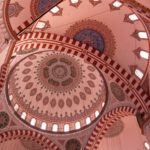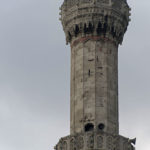Şehzade Mehmed Mosque Complex, Istanbul, Turkey
- View of the interior central and flanking domes of the mosque. Image, L. Jones
- View of the interior central and flanking domes of the mosque. Image, L. Jones
- View of the complex. Image. Accessed 8/9/2019
The complex was commissioned by Süleyman I as a memorial to Şehzade (Prince) Mehmed, the eldest son of Süleyman and Hürrem Sultan. Designed and constructed my Mimar Sinan, it was his first important imperial commission. (fig. 1) The complex consists of a mosque, a türbe or mausoleum, 2 medrese, or religious schools, a kitchen which functioned to serve food to the poor, and a caravanserai, or lodging place, at which merchant travelers could rest and their belongings would be secure. The mosque’s interior is decorated with unglazed tiles, emulating those made in Iznik, but proven to have been manufactured by Iznik-trained craftsmen working in Istanbul.[1] (fig 2). The mosque features 2 minarets that each have 2 exterior gallerys, a design restricted to imperial mosques. The minarets announce Süleyman’s now-thwarted intention to have Mehmed succeed him.
Further reading:
Necipoğlu, Gülru (2005). The Age of Sinan: Architectural Culture in the Ottoman Empire. London: Reaktion Books.


